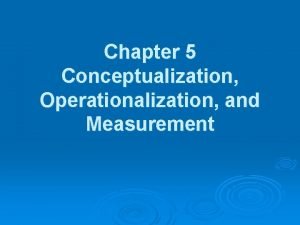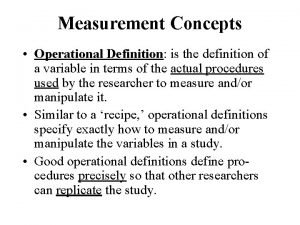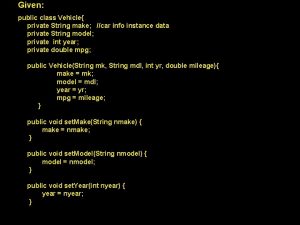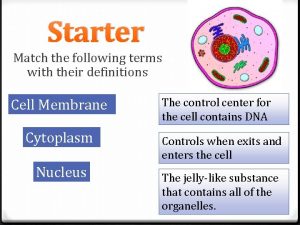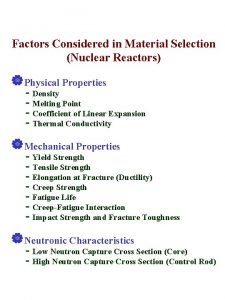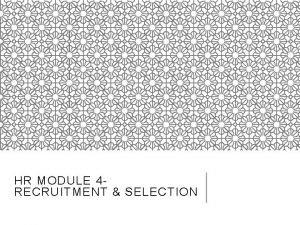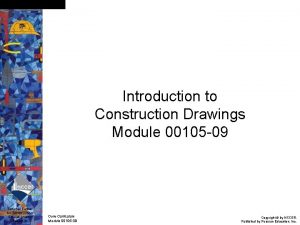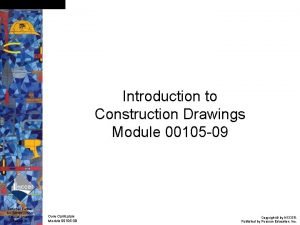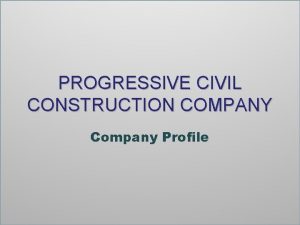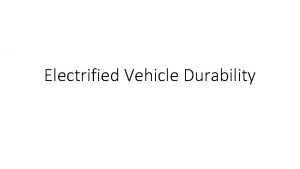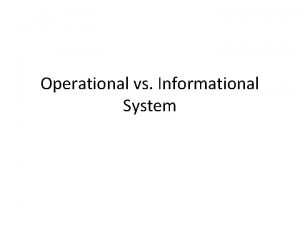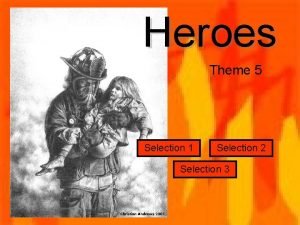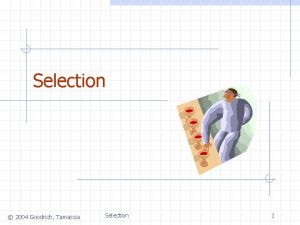Vehicle selection Definitions Operational factors Construction factors Introduction

























- Slides: 25

Vehicle selection • Definitions • Operational factors • Construction factors

Introduction • • When selecting any vehicle it is important that the choice is seen as fit for the purpose. The primary needs can be considered as consisting of the following. 1. The vehicle is constructed with respect to current legal requirements. 2. The construction and the use of the vehicle conforms to the users requirements. 3. Any load and/or passengers carried are done so safely and with maximum efficiency including anthropometric and ergonomic factors. 4. The vehicle has a good operational history of reliability and minimum costs in operation.

Vehicle definitions • • Various legal definitions are used throughout the industry. Motor vehicle A mechanically propelled vehicle intended or adapted for use on the road. Mechanically propelled covers all methods which excludes the use of human and animal muscle. Dual purpose vehicle A motor vehicle designed or adapted to carry both passengers and goods or burden of any description with an unladen weight not exceeding 2040 kg ( further criteria specify details of construction) Trailer A trailer is a vehicle drawn by a motor vehicle

Definitions • • Semi trailer A semi-trailer is a trailer constructed or adapted to form part of an articulated vehicle • • Articulated vehicle An articulated vehicle is a motor car or heavy motor car not being an articulated bus, with a trailer so attached that 20% of its load, when uniformly loaded, is borne by the drawing vehicle

Definitions • Goods vehicle • These are constructed or adapted for the carriage of goods, including trailers. • Motor tractor • Constructed not to carry a load with an unladen weight not exceeding 7340 kg (These can draw two trailers) • Light locomotives • Constructed not to carry a load with an unladen weight exceeding 7340 kg but not exceeding 11690 kg (These can draw two trailers)

Definitions • • Heavy locomotives Constructed not to carry a load with an unladen weight exceeding 11690 kg (These can draw three trailers) Composite trailer A composite trailer is a combination of a converter dolly and a semi-trailer Converter dolly

Definitions • • Light goods vehicle Load carrying where the permissible maximum weight including any trailer does not exceeds 3. 5 tonnes, Medium goods vehicle Load carrying where the permissible maximum weight exceeds 3. 5 tonnes but not 7. 5 tonnes Large goods vehicle 1. An articulated goods vehicle 2. A motor vehicle( not an artic) where the permissible maximum weight exceeds 7. 7 tonnes

Definitions • • • Unladen weight is the weight of a vehicle or trailer including any body and all parts. It does not include. 1. weight of water oil or fuel 2. Tools carried and loose equipment Kerbside weight For a motor vehicle this the weight of the vehicle unladen and carrying no persons but includes a full tank of fuel and other liquids for the running of the vehicle and any loose tolls and equipment with which the vehicle is normally equipped

Definitions Maximum lengths Motor vehicles Construction and Use 12 m Track laying 9. 2 m Vehicle combinations 18 m 18. 75 m with conditions Articulated vehicles 15. 5 m 16. 5 for car transporters, 18 m low loaders Maximum permitted length of any combination 25. 9 m Vehicle conform to Special Type General Order Trailers( semi-trailer) 12. 2 m 12 m for none semitrailers 7 m for most others

Definitions Maximum width Motor vehicle 2. 55 m Locomotives 2. 75 m Trailers 2. 55 m drawn by vehicles exceeding 3500 kg 2. 6 m with refrigerated body 2. 3 m generally, with exceptions

Definitions Authorisation of Special Types (General Order) • 1. An abnormal indivisible load is defined A load which cannot be divided into smaller loads for carrying 2. Due to its dimensions it cannot be carried by vehicles conforming to the Motor Vehicle Construction and Use Regulations 3. Owing to the weight it cannot be carried by vehicles conforming to the C & U requirements

Definitions STGO • Total laden weight • Category 1(C & U) • Vehicle combination up to 46000 kg • Category 2 • Vehicle combination up to 80000 kg • Category 3 • Vehicle combination up to 150000 kg • Vehicle carry identification sign STGO CAT 3

Licensing factors Vocational licensing Operators Licensing Varying age limits control the driving of small, medium and large goods vehicles All goods vehicles exceeding 3. 5 tonne gross plated weight or 1525 kg unladen weight if unplated, are controlled by O. L. requirements

Types of operation Long distance Vehicle power, torque, speed and driver comfort major factors. Short or middle distance inc. local delivery International TIR and CMR Off road Specialised Technical requirements different from mainly road use Reliability factors Access factors and running costs STGO initial cost of equipment very high ADR ATP Very specialised operation requirements

• Long distance Here major considerations will be vehicle power, torque, fuel economy and driver comfort to allow long distances to be covered during a driving day • Multiple deliveries Here the vehicle spends more time being loaded and unloaded than being driven. Hence the body specifications is crucial, and designs which speed the loading and unloading procedures will be an advantage eg sliding doors, curtain sided. • Local deliveries vehicle must be able to gain access easily congestion charging may require alternative fuel engines to avoid payment of the charge • Site work vehicles have to contend with the hazards of soft ground, buried rubble and metal. Robust suspension, tyres, twin drive axles, double reduction and diff locks • International operations vehicles engaged on international operations require conformity in construction with legal requirements of each state they will operate in. Conformity with Transport International Routier (TIR) will be necessary( not required in the EU)

Types of load carried Light bulky Heavy Hazardous Valuable Given physical size Bonded Security Plant

Types of load • Light There are many examples of very light weight products where the cubic capacity of such loads has far more significance than the weight • Heavy Vehicles which will carry heavy loads are often operated under STGO. Similarly vehicle carrying very heavy loads but low volume appear less obtrusive than low mass large bulk • Valuable Vehicles likely to carry high value cargos must be designed with high levels of security for protection of the load. The level of security would be a condition of the goods in transit insurance. Bonded cargos will require very high levels of fidelity to comply with the Customs and Excise requirements • Hazardous cargos Vehicle engaged in any transportation of certain categories of material are required to conform with specified regulations with respect to their construction and the driver qualification. Such international requirements are Accord Dangereux Routier (ADR) • Specialised These include the carriage of animals, for which there are significant legislative factors that affect the vehicle and body construction. The carriage of perishable foodstuffs (Accord Transports Perishables) ATP also has much legislative factors affecting both construction and operation

Type of body Platform Specials Tanker Low loader Tilt/curtain sider Furniture Livestock Demountable Refrigeration

Type of vehicle Rigid Articulated Road train

Construction • 1. 2. 3. 4. 5. 6. 7. The selection must be looked at from the construction, maintenance and economic points. Are the proven models in service? Running and administration costs Reliability Maintenance Conformance to current and projected legislation Crew comfort Costs

Body design factors Aerodynamics Close the gap between tractor and trailer Cab deflectors Aerodynamic cab design Improved fuel economy Air spoilers/air dams Body shape Loads carried People carrier body profiling Cars/minibuses/ PSV, s reduced turbulence Refrigerated/ ATP Low CDA Low frontal area Goods Streamlined body shape Dangerous cargos/ADR solids/liquid/ gases

Vehicle design features

Transmission Clutch final drive gearbox Automatic Fluid coupling single/multiplate Electronically controlled single reduction two speed axle manual semi or fully automatic double reduction inboard reduction outboard reduction single countershaft twin countershaft rangechange/splitter

Multi-axle drive commercial vehicles improved traction use of third diff and diff lock manual selection of diff lock torque split between axles Drive line front/rear wheel drive Four wheel drive common on most modern vehicle may incorporate limited slip diff sports utility vehicle All terrain vehicle Road performance vehicle auto diff lock auto four wheel engagement continuous four wheel drive

Vehicle design factors Vehicle safety Construction factors Ergonomic and Anthropometric factors Operational factors Cab design Cab suspension Loads Restraint systems Power assistance Weight size quantity Impact resistance Seat design Liquids Visibility Driver position Gas Speed limiters Instrument layout Hazardous Type approval Current international standards TIR ATP ADR
 Vehicle selection factors
Vehicle selection factors Difference between conceptualization and operationalization
Difference between conceptualization and operationalization Technical and operational definitions of words examples
Technical and operational definitions of words examples Public class vehicle
Public class vehicle Match the terms with their definitions
Match the terms with their definitions Balancing selection vs stabilizing selection
Balancing selection vs stabilizing selection Artificial selection vs natural selection
Artificial selection vs natural selection K selected
K selected Natural selection vs artificial selection
Natural selection vs artificial selection Difference between continuous and discontinuous variation
Difference between continuous and discontinuous variation What is stabilizing selection
What is stabilizing selection What is exponential growth in ecology
What is exponential growth in ecology Natural selection vs artificial selection
Natural selection vs artificial selection Two way selection and multiway selection
Two way selection and multiway selection Two way selection and multiway selection in c
Two way selection and multiway selection in c Procedure of pure line selection
Procedure of pure line selection Factors considered for selection of materials
Factors considered for selection of materials Factors affecting during the selection of bridges includes
Factors affecting during the selection of bridges includes Factors of natural selection
Factors of natural selection Pump selection factors
Pump selection factors What factors influence satiety?
What factors influence satiety? Recruiting yield pyramid
Recruiting yield pyramid Mask ppe meaning
Mask ppe meaning Introduction to construction drawing
Introduction to construction drawing Intro to construction drawings
Intro to construction drawings Civil company profile
Civil company profile

